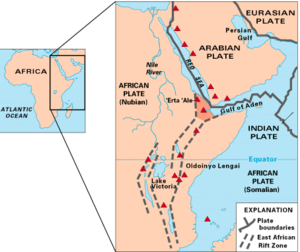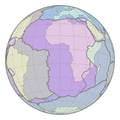African Plate facts for kids
The African Plate is a very large piece of Earth's outer shell, called a tectonic plate. Think of Earth's surface as a giant puzzle made of these plates. The African Plate includes most of the continent of Africa. It also has a lot of the oceanic crust that surrounds the continent. This oceanic crust is the part of the seafloor between Africa and the underwater mountain ranges called ocean ridges.
Sometimes, people call the African Plate the Nubian Plate. This helps to show that it's different from the whole continent of Africa. This is because the continent of Africa actually sits on two main plates: the African Plate and the Somali Plate.
Between 60 million and 10 million years ago, the Somali Plate started to pull away from the African Plate. This pulling apart happens along a huge crack in the Earth called the East African Rift.

Scientists have different ideas about why this pulling apart is happening. One idea is that a very hot column of rock, called a mantle plume, is rising from deep inside the Earth under the Afar region. Another idea is that the rifting is happening because the plates to its east are moving north. This movement creates a weak spot where the African Plate can split.
The African Plate is always moving, but very slowly. It moves about 2.15 centimeters (0.85 inches) each year. For the last 100 million years, it has been moving mostly towards the northeast. This movement is bringing it closer to the Eurasian Plate.
Where the African Plate meets the Eurasian Plate, especially in parts of the central and eastern Mediterranean, the oceanic crust of the African Plate is sliding underneath the Eurasian Plate. This process is called subduction.
Along its northeast edge, the African Plate is pulling away from the Arabian Plate. This pulling apart creates the Red Sea rift.
Long, long ago, the African, Somali, and Arabian Plates were all connected. They were part of a giant southern supercontinent called Gondwana. The Indian subcontinent was also part of Gondwana.
Images for kids
-
Today, the African Plate is moving over Earth's surface at a speed of 0.292° ± 0.007° per million years, relative to the Earth's "average" crust angular velocities (see NNR-MORVEL56)
See also
 In Spanish: Placa africana para niños
In Spanish: Placa africana para niños



